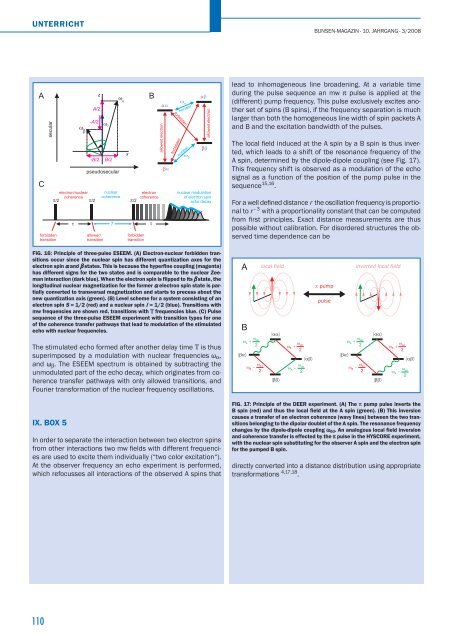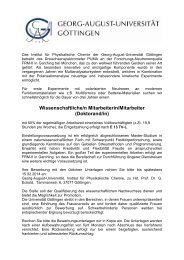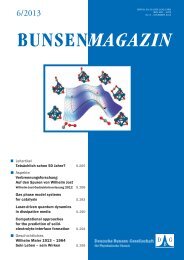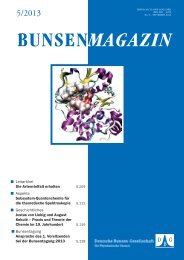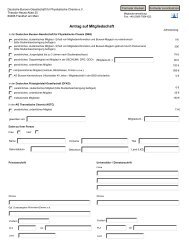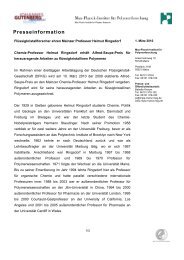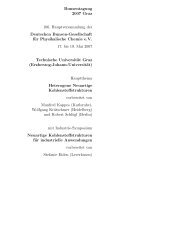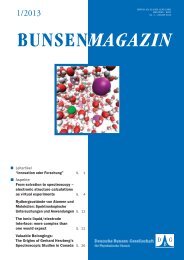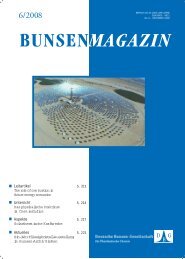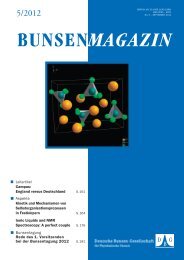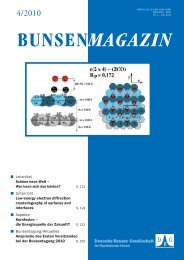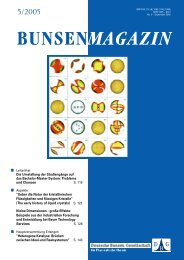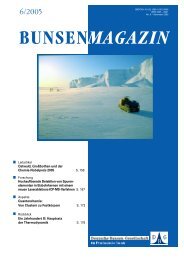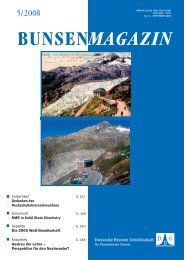bunsenmagazin - Deutsche Bunsengesellschaft für Physikalische ...
bunsenmagazin - Deutsche Bunsengesellschaft für Physikalische ...
bunsenmagazin - Deutsche Bunsengesellschaft für Physikalische ...
Sie wollen auch ein ePaper? Erhöhen Sie die Reichweite Ihrer Titel.
YUMPU macht aus Druck-PDFs automatisch weboptimierte ePaper, die Google liebt.
UNTERRICHT<br />
A z<br />
B<br />
C<br />
secular<br />
forbidden<br />
transition<br />
FIG. 16: Principle of three-pulse ESEEM. (A) Electron-nuclear forbidden transitions<br />
occur since the nuclear spin has different quantization axes for the<br />
electron spin α and β states. This is because the hyperfine coupling (magenta)<br />
has different signs for the two states and is comparable to the nuclear Zeeman<br />
interaction (dark blue). When the electron spin is flipped to its β state, the<br />
longitudinal nuclear magnetization for the former α electron spin state is partially<br />
converted to transversal magnetization and starts to precess about the<br />
new quantization axis (green). (B) Level scheme for a system consisting of an<br />
electron spin S = 1/2 (red) and a nuclear spin I = 1/2 (blue). Transitions with<br />
mw frequencies are shown red, transitions with Τ frequencies blue. (C) Pulse<br />
sequence of the three-puIse ESEEM experiment with transition types for one<br />
of the coherence transfer pathways that lead to modulation of the stimulated<br />
echo with nuclear frequencies.<br />
The stimulated echo formed after another delay time Τ is thus<br />
superimposed by a modulation with nuclear frequencies ωα,<br />
and ωβ. The ESEEM spectrum is obtained by subtracting the<br />
unmodulated part of the echo decay, which originates from coherence<br />
transfer pathways with only allowed transitions, and<br />
Fourier transformation of the nuclear frequency oscillations.<br />
IX. BOX 5<br />
<br />
A/2<br />
- A/2<br />
- B/2 B/2<br />
electron/nuclear nuclear<br />
/2<br />
coherence<br />
/2<br />
coherence<br />
/2<br />
electron<br />
coherence<br />
T<br />
<br />
allowed<br />
transition<br />
I<br />
pseudosecular<br />
<br />
<br />
x<br />
forbidden<br />
transition<br />
nuclear modulation<br />
of electron spin<br />
echo decay<br />
In order to separate the interaction between two electron spins<br />
from other interactions two mw fi elds with different frequencies<br />
are used to excite them individually (“two color excitation“).<br />
At the observer frequency an echo experiment is performed,<br />
which refocusses all interactions of the observed A spins that<br />
110<br />
allowed electron<br />
<br />
<br />
forbidden<br />
forbidden<br />
<br />
nuclear<br />
<br />
nuclear<br />
<br />
<br />
allowed electron<br />
lead to inhomogeneous line broadening. At a variable time<br />
during the pulse sequence an mw π pulse is applied at the<br />
(different) pump frequency. This pulse exclusively excites another<br />
set of spins (B spins), if the frequency separation is much<br />
larger than both the homogeneous line width of spin packets A<br />
and B and the excitation bandwidth of the pulses.<br />
The local fi eld induced at the A spin by a B spin is thus inverted,<br />
which leads to a shift of tbe resonance frequency of the<br />
A spin, determined by the dipole-dipole coupling (see Fig. 17).<br />
This frequency shift is observed as a modulation of the echo<br />
signal as a function of the position of the pump pulse in the<br />
sequence 15,16 .<br />
For a well defi ned distance r the oscillation frequency is proportional<br />
to r –3 with a proportionality constant that can be computed<br />
from fi rst principles. Exact distance measurements are thus<br />
possible without calibration. For disordered structures the observed<br />
time dependence can be<br />
A<br />
B<br />
BUNSEN-MAGAZIN · 10. JAHRGANG · 3/2008<br />
local field inverted local field<br />
pump<br />
pulse<br />
dd A 2<br />
<br />
dd B 2<br />
dd<br />
A<br />
2<br />
<br />
dd<br />
B<br />
2<br />
<br />
<br />
<br />
<br />
dd B 2<br />
<br />
dd<br />
A<br />
<br />
2<br />
dd<br />
B<br />
2<br />
<br />
dd<br />
A<br />
<br />
2<br />
FIG. 17: Principle of the DEER experiment. (A) The π pump pulse inverts the<br />
B spin (red) and thus the local field at the A spin (green). (B) This inversion<br />
causes a transfer of an electron coherence (wavy lines) between the two transitions<br />
belonging to the dipolar doublet of the A spin. The resonance frequency<br />
changes by the dipole-dipole coupling ωdd. An analogous local field inversion<br />
and coherence transfer is effected by the π pulse in the HYSCORE experiment,<br />
with the nuclear spin substituting for the observer A spin and the electron spin<br />
for the pumped B spin.<br />
directly converted into a distance distribution using appropriate<br />
transformations 4,17,18 .


